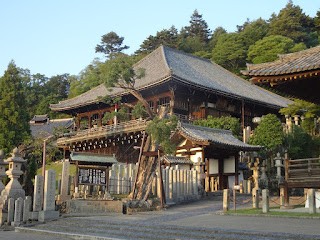"The Great Buddha of Nara" is a Buddha that every Japanese knows. The Great Buddha is enshrined at Todai-ji Temple. Todai-ji is a temple built by the Emperor Shomu in the Nara period.
Many of the buildings and Buddha statues are national treasures, and were registered as a World Heritage Site in 1998. Let's walk through the vast precincts of Todai-ji Temple where the time of 1300 is breathing ♪
Start from the intersection of "Daibutsudenmae"
About a 20-minute walk from Kintetsu Nara Station to the west, get off the city bus at "Daibutsuden Kasuga Taisha-mae".
Souvenir shops line up on the left side of the path, and deer welcome you! First of all, let's buy a deer senbei (cracker) for the welcoming deer. They welcome you with a surprise bite!!
Nandai-mon Gate
First, stop on the approach and carefully observe the 25m high gate, which is the largest temple gate in Japan.
 |
| Nandai-mon Gate |
It was built during the Kamakura period and is designated as a national treasure.
The highlight is the wooden statue of the "Kongo Rikishi-zo" that stands on both sides of the gate. It is a huge wooden statue with 8.4 meters high which is also a national treasure. On the right side of the gate is a statue of "Ungyo (closed mouth)", and on the left is the statue "Agyo (open mouth)". It is made of parquet made of about 3,000 components, and it is surprising that it was made in about two months!
Kagami Pond & Ticket Gate
When you pass through Nandai-mon Gate, you can see the Kagami Pond on your right side.
Then, you will see the middle gate in front of you. Behind it is the Great Buddha Hall. Go left on the corridor to the entrance gate of the Great Buddha. First, pay the admission fee here.
Great Buddha Hall
Inside, you will find the world's largest wooden building, the Great Buddha Hall.
Finally let's go inside the Great Buddha Hall.
The massive Buddha statue is enshrined here.
Look up his face and greet the Big Buddha, who wraps people with great love.
The right hand means "we will not be afraid" and the left hand means "let's fulfill the wishes of the people."
The great Buddha was enshrined in 743 by Emperor Shomu.
During the time of political unrest, droughts, famines, and smallpox, the Emperor struggled with that and founded himself with the power of Buddhism.
With a total of 2.6 million people from all over the country, building the Great Buddha was a major project in the country.
Nine years after Emperor Shomu's decree, the opening ceremony of the Great Buddha was celebrated in 752, and the Great Buddha has been watching over us for 1,260 years.
 |
| The model of original Todai-ji Temple |
Go through pillow
At the Great Buddha Hall, one of the most popular places for foreign tourists and children is the hole in the pillar, which is the same size as the Great Buddha's nostrils. It is said that if you go through the hole, you will benefit from no illness. The pillar hole is located in the northeast of the Great Buddha Hall, the place of the Onimon (demon gate), which was originally opened to escape evil.
In addition, there is a large souvenir shop inside the Great Buddha Hall,
selling Todaiji original goods, cute deer items and souvenirs from Nara!
Nigatsu-do Hall
The highlight of Todai-ji Temple is not just the Great Buddha and the Great Buddha Hall.
Nigatsu-do Hall, also known for its Omizu-tori event that tells the coming of spring, is also a famous building of Todaiji Temple. From the back of the Great Buddha Hall, there is an approach to Nigatsu-do Hall, where you can feel the atmosphere of the ancient city of Nara, with a cobblestone road surrounded by clay walls.
Nigatsu-do Hall, also known for its Omizu-tori event that tells the coming of spring, is also a famous building of Todaiji Temple. From the back of the Great Buddha Hall, there is an approach to Nigatsu-do Hall, where you can feel the atmosphere of the ancient city of Nara, with a cobblestone road surrounded by clay walls.
This is the stage of "Shunie", which is held every year from March 1st for two weeks. Shunie is a memorial service in which monks confess to the principal god and eleven-faced Kannon of Nigatsu-do the various mistakes people are committing in their daily lives and wish for the well-being of people.
There is a wooden bench, so it is a perfect place to take a break after walking around the large precincts.
Despite being a national treasure, Nigatsu-do is open to the public 24 hours a day.
On the way back, it is recommended to use the cobblestone path leading to the back of the Great Buddha Hall.
The course I introduced this time is only a part, and there are several other historical temples at Todaiji Temple.
▶A 5-minute walk from "Daibutsuden Kasuga Taish-mae" bus stop. Take a city shuttle bus from the Nara Station on the JR Yamatoji Line / Kintetsu Nara Line.
▶Take "Gurutto-bus (Omiya-dori route / Nara Park route)" from Nara Station on Kintetsu Nara Line, and get off at the "Daibutsuden-mae parking lot".
























No comments:
Post a Comment